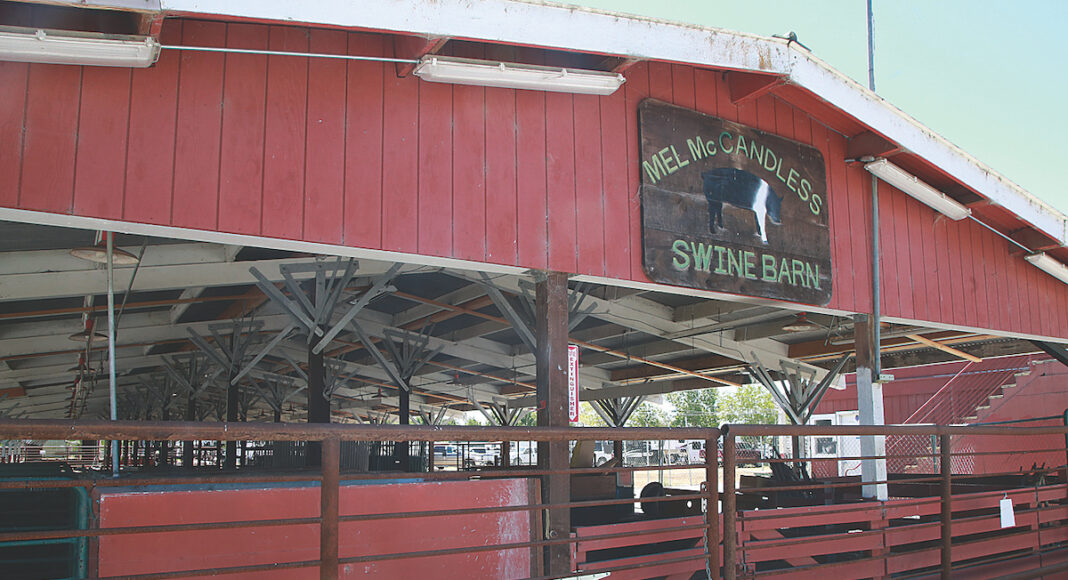When thousands of attendees file into the Santa Cruz County Fairgrounds in September for the annual county fair, they can expect the east end of the grounds to look much different than years prior.
If all goes according to plan—and government agencies work at hyper-speed over the next few weeks—pig and sheep pole barns that have been deemed unsafe will be dismantled to possibly make way for a new state-of-the-art multi-purpose building.
While the construction of the multi-million-dollar building is part of a long-range plan that is still in its infancy, the dissembling of the weathered, 67-year-old barns is now at the top of Fairgrounds CEO Dave Kegebein’s to-do list in the weeks leading up the Santa Cruz County Fair.
The Fair Board at a special meeting on Tuesday directed Kegebein to move forward with the removal of the barns, pending approval from various state agencies. The board voted 6-2—Director Michael Pruger was absent—on the motion. Board President Don Dietrich and Director Tony Campos cast the dissenting votes.
The item came to the board on Kegebein’s recommendation. He said their removal is needed because the barns pose a safety hazard. In addition, Kegebein said the move would allow county fair organizers to keep the beloved livestock displays in the same location with temporary display pens and tents.
It’s unclear whether Fairgrounds leadership will receive the approvals they need from the state to dismantle the barns in time for the county fair, which is scheduled for Sept. 14-18. If they do not, Kegebein said they will have to cordon off the barns and use other areas on the Fairgrounds for the livestock displays.
Both Dietrich and Campos, in explaining their votes, said they preferred keeping the barns up and fenced off for the county fair and revisiting the topic at a future date when Fairgrounds leadership had the approval of the state, which oversees the facility.
But their peers said that keeping them around could be a hazard for the thousands that are expected to attend the fair over its five-day run and that if Kegebein does not receive state approval to remove the barns before the start of the event, they will be fenced off regardless.
The barns were built in 1955.
According to Kegebein, they have been in disrepair for at least 10 years. An inspection in 2012-13 found that more than half of the posts that hold up the roofs have been rotted off their base. Since then, they’ve made small but pricey renovations each year to prepare them for the fair.
The barns have become a much-debated issue over the past few weeks as people have raised concerns about what their removal could mean for the future of the livestock displays, and the Fairgrounds’ responsibility as an emergency evacuation center.
In his presentation to the board, Kegebein addressed those concerns, saying that the county fair had no plans to cut ties with its livestock displays—he says they are one of the festivity’s biggest draws and hopes to expand the organization’s relationship with local FFA programs—and that the organization had plans in place to provide emergency shelters for animals if another local catastrophe similar to the 2020 CZU Lightning Complex were to happen in the near future.
About four dozen people showed up to the evening meeting at the Fairgrounds’ Fine Arts Building—a larger than usual turnout, several board members said.
A couple of people said that Fairgrounds leadership was wrong in its assertion that the barns were beyond repair, and asked that the board instead invest the money to renovate them so that the livestock community is not displaced for several years while the organization fundraises for a pricey multi-purpose building.
A handful of other speakers, however, said that the board needed to move forward with the removal and the proposed building that they said could be a year-round revenue generator for the fairgrounds and solve many of the livestock community’s issues with the current barns.
“Each year we are putting bandaids on buildings that have been around for generations,” said Kyle Middleton, a member of the Fair Board’s Livestock Committee. “We’ve always understood that it is not fiscally responsible to put tons of money into buildings that only get used for one week out of the year—we have to take the first step into the future in order to preserve our past.”













